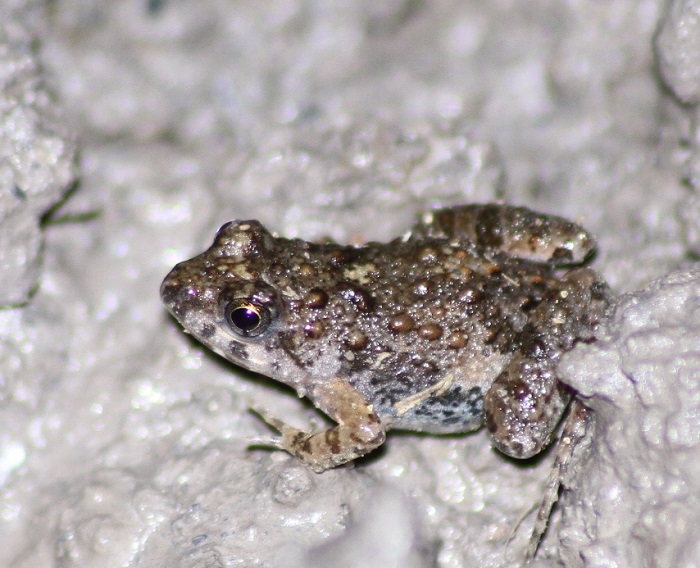View the above photo record (by John Wilkinson) in FrogMAP here.
Find the Dwarf Puddle Frog in the FBIS database (Freshwater Biodiversity Information System) here.
Family Phrynobatrachidae
DWARF PUDDLE FROG – Phrynobatrachus mababiensis
FitzSimons, 1932
Identification
Habitat
P. mababiensis inhabits open to wooded savanna and, less frequently, grassland, where summer rainfall is 500–1000 mm p.a. It breeds in shallow stagnant water amongst emergent vegetation on the edges of grassy pans, vleis, marshes, small dams and ponds, and in the backwaters of slow-flowing streams. The species is also found in disturbed habitats near villages and other developments.
Behaviour
Dry periods are spent in aestivation. During the dry winter at Shipudza (2230DB) in Kruger National Park, adult P. mababiensis were found sheltering under stones (H. Braack pers. comm.).
This species has an extended breeding season that begins after the first spring rains. Males call from the water’s edge, well concealed by vegetation. Choruses are usually strongest at dusk, diminishing after nightfall. In overcast or rainy weather, calling continues throughout the day and night. Aggression between males occurs frequently (Wager 1965).
Eggs are laid in a single flat layer c.5 cm in diameter, that floats on the water. Metamorphosis is completed after about five weeks, at which stage the juvenile froglets are only 6 mm long (Wager 1965; Pienaar et al. 1976).
P. mababiensis feeds mainly on small insects such as midges and mosquitoes (Wager 1965). These frogs occur in large numbers and probably play a significant role in the ecology of their wetland habitat. Stewart (1967) regarded this species as “probably the most abundant amphibian in eastern and central Africa”.
Predators have been recorded in East Africa (Loveridge 1953a) and Zimbabwe (Broadley 1974). These include various snakes such as the Herald Snake Crotaphopeltis hotamboeia and Swamp Viper Atheris nitschei. Other predators include the Cattle Egret Bubulcus ibis.
Status and Conservation
This successful and widespread species is not in need of special conservation measures.
Distribution
Several small Phrynobatrachus species were described from central, eastern and southern Africa, but the taxonomy of this group is still unsettled (Poynton and Broadley 1985b; Lambiris 1989a).
P. mababiensis occurs from the Sahel of East Africa to the Eastern Cape Province, South Africa, west to Namibia and southern Angola (Frost 2000). In the atlas region, it is found along the coastal plain from about Qolora Mouth (3228CB) in Eastern Cape Province, northward through KwaZulu-Natal, Swaziland, Kruger National Park and surrounding lowlands, from sea level to 1500 m. Earlier records from the western parts of Limpopo Province indicate that this species may be expected to occur across the province via the Limpopo valley.
The colouration and markings of this species vary considerably, but its small size and characteristic insect-like call make identification relatively easy. The call may at times be confused with that of Hemisus marmoratus, which has a similar pulse rate and emphasized frequency. However, the latter lacks the sporadic clicks that are interspersed in the trill of P. mababiensis.
The atlas data are accurate and reasonably complete
Further Resources
Virtual Museum (FrogMAP > Search VM > By Scientific or Common Name)
More common names: Dwergmodderpadda (Afrikaans)
Recommended citation format for this species text:
Channing A, Tippett RM. Dwarf Puddle Frog Phrynobatrachus mababiensis. BDI, Cape Town.
Available online at http://thebdi.org/2021/12/20/dwarf-puddle-frog-phrynobatrachus-mababiensis/
Recommended citation format:
This species text has been updated and expanded from the text in the
2004 frog atlas. The reference to the text and the book are as follows:
Channing A 2004 Phrynobatrachus mababiensis Dwarf Puddle Frog. In Minter LR
et al 2004.
Minter LR, Burger M, Harrison JA, Braack HH, Bishop PJ, Kloepfer D (eds)
2004. Atlas and Red Data Book of the Frogs of South Africa, Lesotho and
Swaziland. Smithsonian Institution, Washington, and Avian Demography
Unit, Cape Town.

